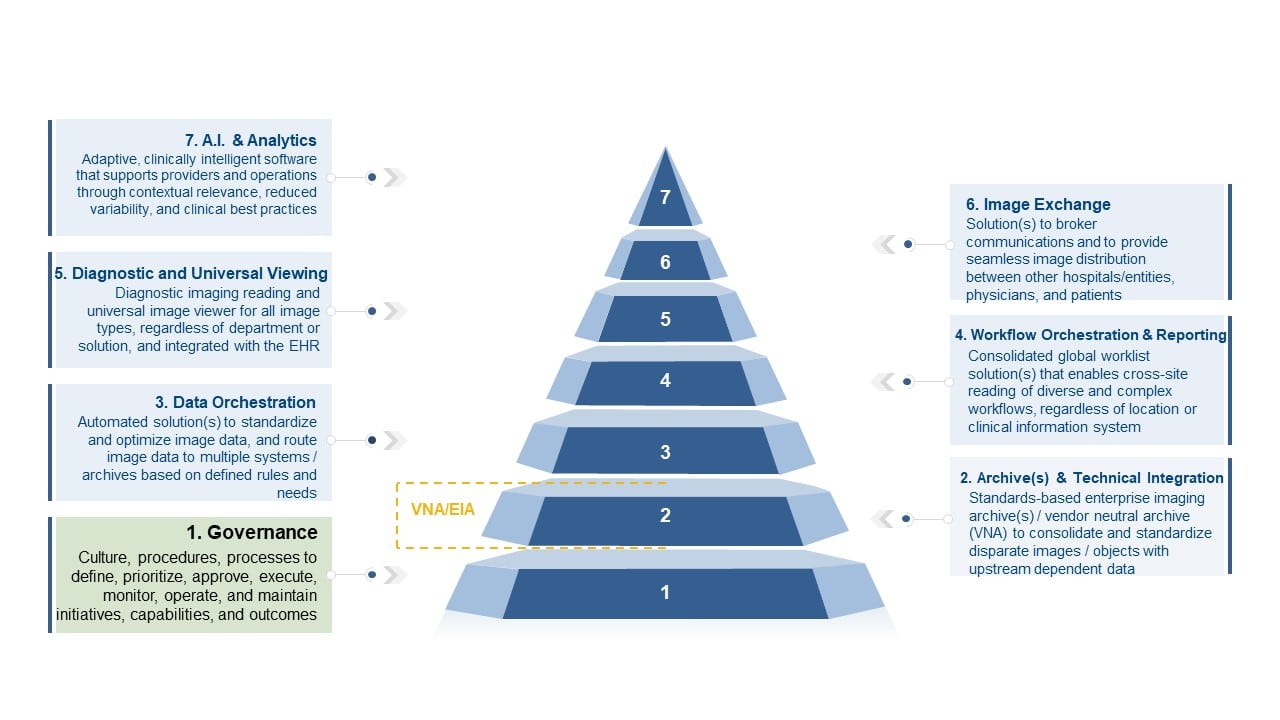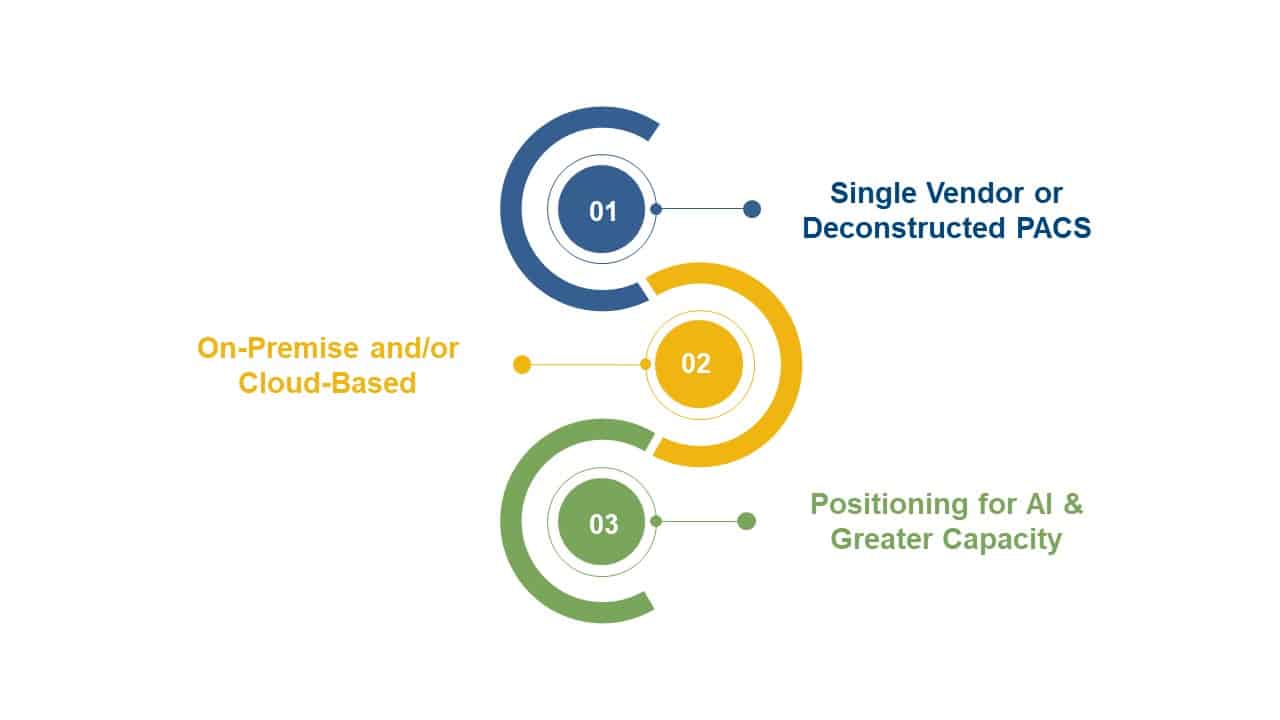Key Considerations When Defining Your Enterprise Imaging Strategy

Hospitals and health systems have disparate technologies and processes in the current medical imaging environment. Teams are siloed by clinical service line, department, or “ology,” and forced to manage growing volumes of imaging data amid higher delivery complexity. Further exacerbating these challenges are the increasing organizational demands for improved efficiency, capacity, and value.
Having an enterprise imaging strategy closely aligned with your organization’s priorities can ensure your hospital or health system gets the most value from your imaging assets while delivering integrated, high-quality care across the enterprise and supporting the unique imaging needs of each clinical service line, department, or “ology.”
Governance is a Foundational Component of Enterprise Imaging
The goal of enterprise imaging is to collect all forms of image data from multiple clinical areas and manage them on a common platform accessible to all approved users. While there are many core enterprise imaging components, having a strong governance model and framework is foundational.
Core Enterprise Imaging Components

Approaches to enterprise imaging governance will vary from organization to organization given inherent differences in the clinical services offered, organizational structure, and other IT governance committees, but there are key questions that any hospital or health system should ask. For example, have you considered the impact of your culture on enterprise imaging governance? Are key stakeholders engaged? Is there representation from physicians, nurses, and allied staff – in addition to the operations and IT teams? Is there rigor and structure across the enterprise around how imaging initiatives are identified, processed, prioritized, monitored, and maintained? Do you have defined technical, business, and/or operational architectures that Enterprise Imaging initiatives must adhere to?
A strong governance foundation will support informed, collaborative decision-making as you define your enterprise-wide imaging strategy – and will ensure that strategy is closely aligned with your organization’s unique priorities and goals.
Three Considerations When Defining an Enterprise Imaging Strategy
Three critical considerations when defining your enterprise imaging strategy are 1) how you approach the vendor market, 2) how you approach on-premise vs. cloud-based architecture options, and 3) how you position your imaging environment for the future with AI.
Three Critical Enterprise Imaging Considerations

1. Single Vendor or Deconstructed PACS
Some organizations will decide to partner with a single imaging vendor across the enterprise, while others will take a “deconstructed PACS (picture archiving and communication system)” approach. There are multiple options, which will be based on organizational and technical requirements. It is unlikely there will be a single imaging vendor that can fully meet every need of all your departments as well as the enterprise, so when determining the right approach for your hospital or health system it is important to understand the trade-offs between a single vendor vs. a deconstructed PACS approach. Some of those trade-offs may include degree of open standards adherence, future stability and commitment to the enterprise imaging market, and amount of innovation and delivery execution to support your evolving needs. For example, while there may be niche imaging vendors with promising new functionality, emerging imaging domains such as digital pathology and point-of-care ultrasound (POCUS) may not be as far along from a standards adherence perspective.
2. On-Premise and/or Cloud-Based
There is growing interest in moving imaging systems and data to the cloud to realize the benefits of greater elasticity and scale. However, it is critical that your organization aligns any potential architecture decisions (whether on-premise and/or cloud-based) with your specific enterprise imaging goals and technology constraints (e.g., performance and integration with dependent applications). Business continuity and disaster recovery are key considerations as well.
It is also important to carefully evaluate architecture options to avoid unnecessary ingress/egress costs or duplicative fees. For example, multiple imaging applications may reside in the same cloud region, yet the dataflow does not support optimal data routing. Pay close attention to the opportunity of multi-cloud environments, which might increase cost and complexity, but can provide crucial continuity, availability, and risk mitigation benefits.
3. Positioning for AI and Greater Capacity
There is no question about artificial intelligence’s potential to transform hospital and health systems’ imaging environments, such as by improving study prioritization, reducing study reporting strain, lowering administrative work burden, and bettering specialty detection. However, it is important to remember that clinical AI use cases are still maturing, with no vendor currently offering a complete imaging-specific solution. With any new AI tools, it is critical to validate the technology against your data to assess overall and on-going quality and reliability.
Strong data governance, data standardization, and change management are essential for success. For example, how will you incorporate new AI tools and capabilities into your imaging environment? How will end users report false positives or false negatives to ensure there is a continuous feedback loop? When designing your enterprise imaging environment and bringing AI tools into that environment, how do you decide whether to bring your data to the AI platform or bring the AI platform to your data?
The Bottom Line
Increasing volumes of medical images, capacity constraints, and organizational demands for improved efficiency and value will continue. Enterprise Imaging can ensure your hospital or health system delivers integrated, high-quality care while also getting the most value out of your imaging assets and effectively supporting the unique imaging needs of each department. Governance is paramount when defining your enterprise imaging strategy, and careful consideration needs to be given to how you approach the vendor marketplace, emerging architecture options, and new AI tools.
Impact Advisors can help you bring clarity to the ever changing and complex enterprise imaging ecosystem to provide greater integration, performance, efficiency, capacity, and certainty to meet your challenging clinical and business priorities and medical imaging needs.

























